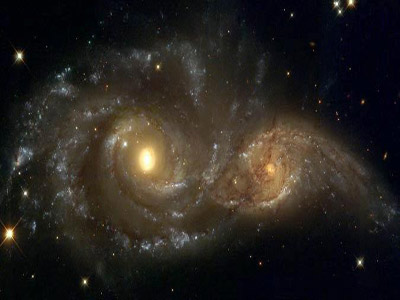
New Scientist reports:
Astronomers have spotted two colossal black holes that appear to be orbiting each other 100 times closer than any previously seen. But they are still too far apart to produce large ripples in the fabric of space-time – suggesting some black holes may 'stall' before spiralling towards each other and merging.
When two galaxies collide, the black holes at their cores are thought to fall towards the centre of the resulting larger galaxy. These black holes then go into orbit around each other and should eventually merge. "But no one has ever found a really clear example of a binary black hole before," says David Merritt, an astrophysicist at the Rochester Institute of Technology in New York, US.
A 'wide' binary system was found with black holes within 3000 light years of each other in 2002, and earlier in April, another was announced at a separation of 28,000 light years.
Now, astronomers led by Cristina Rodriguez at the University of New Mexico in Albuquerque, US, have found what appear to be two black holes within 24 light years of each other. The pair was identified using the Very Long Baseline Array, a system of 10 radio dishes scattered from Hawaii to the Caribbean Sea. The VLBA boasts the sharpest resolution of any telescope in existence.
Sloshing gas
The objects are buried within a blob-shaped galaxy called 0402+379, which lies about 470 million light years from Earth. Both appear to be "active" black holes that are devouring their surroundings.
The team says spectral observations taken with the Hobby-Eberly Telescope in Texas confirm the objects are indeed orbiting each other and have a combined mass of 150 million of our sun.
But Merritt, who is not on the team, cautions that one black hole may actually lie farther from the other than expected. That is because the spectrum attributed to the orbital movement of the second black hole might simply be due to gas sloshing around the first. "I think it's likely they are actually close, but it's difficult to make the case airtight," he told New Scientist.
If the black holes are indeed just 24 light years away from each other, they could help researchers understand the black hole merger process. At extremely close distances – perhaps 1000 times closer than this pair – black holes are thought to be inexorably drawn together as they lose angular momentum by radiating gravitational waves that ripple space-time.
Losing momentum
But in order to get to such tight orbits, the behemoths must lose energy some other way. Researchers think they may get rid of angular momentum by flinging nearby stars and gas outwards at high speed. "If that happens enough, you could shrink their orbit," says Merritt. "But there are big uncertainties – how many stars are there that find their way close to the binary system, and how much gas is down there?"
Team member Gregory Taylor at the University of New Mexico agrees: "They have to lose angular momentum, but we don't know if that's an easy thing to do or a hard thing to do," he told New Scientist. "Do they just get stalled – or do they never get together?"
This pair certainly appears to have become stalled at least, says Merritt. That is because the black holes are still too far apart to begin emitting gravitational waves – even though their host galaxies probably merged millions or billions of years ago. "It wouldn't prove all binaries stall like this, but it shows there's one case where it seems to be happening," he says.
------------

No comments:
Post a Comment